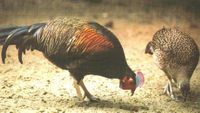Chicken - Ceylon Jungle Fowl
Ceylon Junglefowl Scientific Name: Gallus lafayettei
Tue, 29th April, 2025 - 3:51 pm GMT
Sponsor Ads:

Alternative Name
Ceylon Junglefowl Scientific Name: Gallus lafayetteiBasic Info
The Ceylon Junglefowl differ in coloration between the sexes. Male Ceylon Junglefowl are about 70 cm long and females are half this size. The male is more striking than the female with a bright-red, featherless face and wattles. Ceylon Junglefowl have reddish-orange legs. The head is topped with a comb, which may be slightly jagged and has a spot of bright yellow. The comb shrinks in summer. Also yellow are the hackles, accented by a shaft of brown-black color. These will molt. Most of the Ceylon Junglefowl?s body is a shiny blackish-purple, except for the mantle, breast and outerwing feathers, which have orange borders and black-brown interiors. On the Ceylon Junglefowl?s saddle and back, the feathers are also bordered in orange. The female Ceylon Junglefowl has feathers on her face, which are brown and very small. She has no wattles and her comb is tiny, just a purplish-black lump behind her beak. Her legs are red-orange, like the males, but the majority of her body is covered in brown feathers. Her hackles are characterized by small black patches with yellow accents. On her brown upper breast, Ceylons have a large tan or cream central lanceolate. The feathers of the lower breast are typically white with black or brown feathers interspersed. The Ceylon Junglefowl has tan or cream stripes, which alternate with black stripes over her wings.
Health
Ceylon Junglefowl cover their cold-sensitive toes with their breast feathers while roosting, so large-diameter perches should be provided to accomodate this habit. It is important also to find a veterinarian experienced in the care of Junglefowl in case of emergency. Breeding Ceylon Junglefowl breed in the spring and in August to September. They lay eggs of a dirty-white colour in ground-built, open nests. Three to six eggs typically are incubated for 21 days, when some will hatch. The eggs are sized about 48mm X 35mm and generally the chicks are strong. However, because they are so shy and nervous, they may injure themselves or suffer from stress.Habitat
N/ABehavior
A striking and beautiful bird, the Ceylon Junglefowl is timid and has been valued as a rare pet for years. The Ceylon Junglefowl is native to Sri Lanka, from whence it derives its name; Sri Lanks was once called Ceylon. In the wild, it eats seeds, grains and insects and lives in the trees. Nests are built on the ground. These nests are open and are used for the Ceylon Junglefowl?s eggs in breeding season. They are located under bushes or trees. The birds become territorial during mating and establish their nests and areas by calling to each other. The Ceylon Junglefowl is closely related to the more common Red Junglefowl. Since they are accustomed to a tropical climate, it is essential that in captivity the Ceylon Junglefowl be kept in a very warm aviary. Their diet should consist mostly of grains and seeds and supplemented with fruits or insects like mealworms on occasion. Because Ceylon Junglefowl are extremely shy by nature, they should be provided with lots of foliage and a large aviary in which to hide.Origin
Sri LankaHistory
The Ceylon Junglefowl has been described by several naturalists in their native habitat of Sri Lanka. They observed that the Ceylon Junglefowl frequents the drier areas of the scrubland along the coast, but the birds have also been found in low-elevation rainforests. Extremely shy, they are a rare pet, because it was difficult for the natives to catch them. They were brought to the United States in the 1950?s and their population there arises from the Suthard line of birds. Worldwide Ceylon Junglefowl remain rare in captivity.Common Foods
N/ASponsor Ads:
"Poetry is finer and more philosophical than history; for poetry expresses the universal, and history only the particular." -- Aristotle. Poetics.(1451b6). 350 BCE.
Chicken - Ceylon Jungle Fowl
Coded by: BGID® | ALL RIGHTS RESERVED Copyright © 2000-2025
Disclaimer | Privacy | Report Errors / Contact | Credits

 Preparing For China. China is growing their military. China Military Technology - can it keep up with the US?
Preparing For China. China is growing their military. China Military Technology - can it keep up with the US?  versus
versus 

 versus
versus 
 This Thread is about the North Korean Military itself - the kind of army, navy, and air force they have.
This Thread is about the North Korean Military itself - the kind of army, navy, and air force they have. 
 versus
versus 
 versus
versus  versus
versus